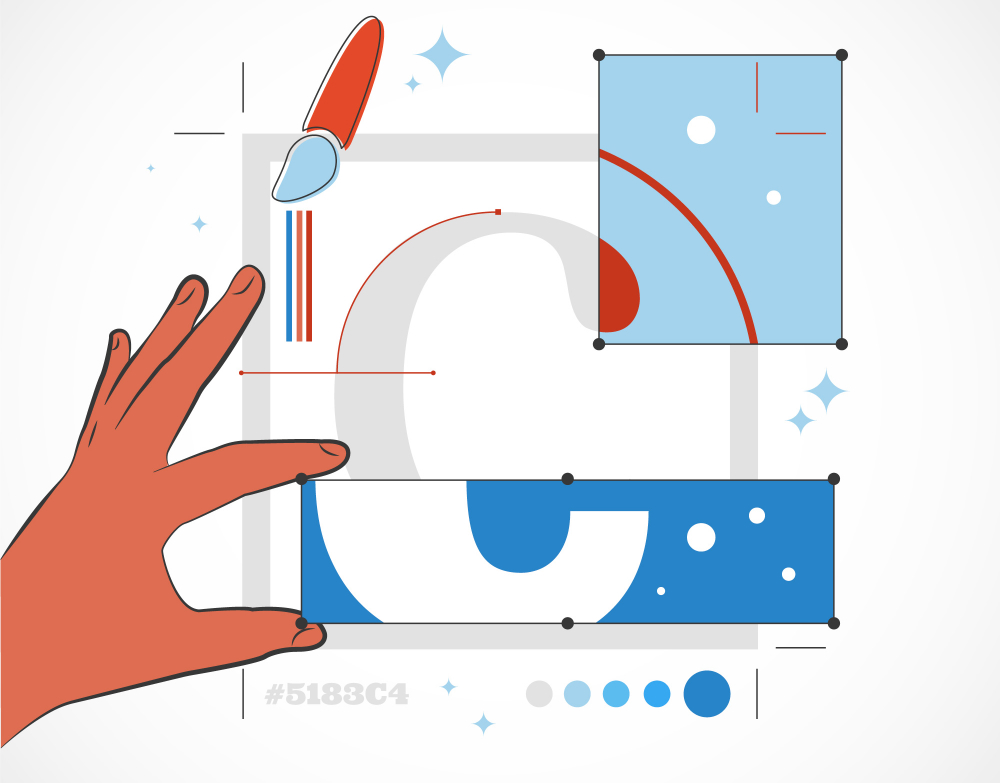
The Impact of Graphic Design on Social Media Marketing
The Rising Importance of Graphic Design in Digital Spaces
In today's fast-paced digital world, graphic design has become a cornerstone of how we consume content. As businesses undergo digital transformation, the virtual realm has become saturated with content, making it crucial for brands to stand out. Graphic design serves as a beacon, highlighting the essence of a brand amidst the plethora of digital information. It’s no longer about being seen; it’s about being remembered. Every pixel and every color choice contributes to a brand’s online presence, carving its niche in the vast digital expanse.
Graphic Design and Its Direct Link to Social Media Marketing
When we think about social media, we envision feeds filled with vibrant images, captivating videos, and interactive graphics. It's this tapestry of digital artwork that breathes life into a brand's online narrative. Well-designed visuals not only engage but also retain audience attention, driving them to interact, share, and return for more. The fusion of graphic design and social media marketing has paved the way for a more interactive and immersive online brand experience, turning casual browsers into avid followers.
Setting the Stage: The Key Components in the Intersection of Design and Social Media
It's a dance between visuals and strategy. Effective social media marketing hinges on captivating multimedia elements merged seamlessly with a brand’s corporate identity. The visual language needs to echo the brand's voice, ethos, and vision. Every design choice, from color palettes to typography, molds the perception and recognition of the brand among its digital audience.
Understanding Graphic Design in the Digital Age
What is Graphic Design?
Graphic design transcends mere aesthetics. It's a potent communication tool, conveying ideas, emotions, and stories through visuals. In the digital age, it has transformed from static images on paper to dynamic, interactive designs that adapt to different screens and platforms. Digital artwork now incorporates motion, sound, and even touch, crafting a multi-sensory experience for the user.
Visual Content: More than Just Pretty Pictures
Content is king, but visual content wears the crown in the digital kingdom. With the surge in online content consumption, users are swamped with information. Here, visual content becomes the anchor, succinctly conveying messages that could take paragraphs of text. Infographics, GIFs, memes, and short videos distill complex ideas into easily digestible, shareable chunks, amplifying brand reach and recognition.
The Role of Branding in Modern Business
A brand is more than its products or services. It's an experience, an emotion, a story. In today's digital age, branding is how a business introduces itself to the world. Through consistent and adaptive design choices, businesses craft their unique identities. This visual consistency, enhanced by design innovation, ensures that every touchpoint, whether a website banner or an Instagram post, resonates with the brand's core essence.

The Pillars of Social Media Marketing
Social Media Platforms: The Battlefields of Brands
The digital landscape is dotted with myriad social platforms, each with its unique audience and style. Understanding platform algorithms, like Facebook's EdgeRank, becomes pivotal. These algorithms dictate content visibility, making it imperative for brands to not only create stellar content but also to optimize it for each platform. As brands jostle for user attention, tailored strategies for each platform, from Twitter's rapid-fire updates to Instagram's visual stories, become the keys to success.
User Experience (UX): Crafting Memorable Digital Journeys
In the realm of social media, UX goes beyond website navigation. It encompasses every interaction a user has with a brand online. A seamless, user-centric design across platforms ensures that the user's digital journey is intuitive, enriching, and memorable. From the ease of finding information to the joy of sharing a fun post, every design choice should prioritize the user, turning their online interactions into lasting brand relationships.
The Significance of Engagement Rate in Social Media Success
Beyond mere numbers, engagement rate is a testament to a brand's digital efficacy. High engagement signifies resonant content that sparks conversations, evokes emotions, and fosters brand loyalty. It's not just about garnering likes or shares; it's about kindling meaningful interactions, ensuring that the audience is not just passively consuming but actively participating in the brand's digital narrative.

Merging Graphic Design with Social Media Strategy
Social Media Aesthetics: Why Looks Matter
Aesthetic isn’t a superficial aspect of a brand’s presence. It’s the essence of its identity. Especially in an era characterized by the prominence of visual platforms like Instagram and Pinterest, a brand's look directly correlates with its perceived value and credibility. However, aesthetics isn't solely about attractiveness. A visually pleasing design often coincides with clarity, functionality, and user-centric design. By ensuring visual consistency, brands establish a trustworthy image, fostering deeper audience engagement and increasing brand recognition.
Visual Strategy: Planning for Coherence and Impact
Mapping a visual strategy is akin to charting a brand’s journey in the digital realm. It’s about anticipating trends, understanding audience preferences, and aligning these with the brand’s essence. Such strategies prioritize visual coherence, ensuring that regardless of the medium or platform, the audience experiences a consistent brand narrative. This involves integrating various elements of design innovation, multimedia elements, and even adaptive design to cater to diverse user interfaces. As the digital marketing evolution continues, the fusion of design and strategy becomes more crucial.
Design Trends: Staying Relevant in a Constantly Changing Medium
The digital landscape is dynamic. Trends come and go at the speed of scrolling fingers. Brands must harness these changing tides, integrating design trends without losing their core identity. Whether it's the minimalist designs of today or the neon palettes of the '80s, staying relevant ensures the brand remains part of contemporary conversations. Yet, it’s vital to discern between fleeting fads and impactful trends, as the latter often signifies deeper shifts in user behavior and preferences.
Tools and Techniques for Enhanced Social Media Presence
Graphic Tools: From Adobe to Canva - Making Design Accessible
In the digital era, the tools we wield define the art we create. Advanced design software like Adobe's suite allows for intricate designs and precise edits, while user-friendly platforms like Canva democratize design, allowing even novices to create compelling visuals. These tools undergo constant enhancement, offering newer capabilities that cater to evolving design needs. Through these graphic tools, brands can achieve professional-grade designs without the hefty price tag, ensuring their social content remains top-notch.
Content Creation: Crafting Posts that Resonate and Engage
Content creation isn’t just about quantity; it's the quality and relevance that count. Leveraging analytics and metrics helps brands discern what resonates with their audience, allowing for tailored content strategies. The fusion of compelling visuals with captivating narratives can turn a simple post into a viral sensation. Moreover, integrating cross-disciplinary collaboration ensures content is well-rounded, leveraging expertise from different fields for holistic content creation.
Visual Engagement: Metrics that Matter
In the labyrinth of digital metrics, visual engagement stands out. It’s not just about views or clicks but how deeply a user interacts with the content. High visual engagement signifies a design's success in captivating its audience, driving them to delve deeper, share, and even contribute. As brands refine their integrated marketing communication, prioritizing visual engagement ensures they are genuinely connecting with their audience.

Conclusion
Reflecting on the Impact of Graphic Design on Social Media Marketing
The interplay between graphic design and social media marketing is undeniable. They are two facets of the same coin, each amplifying the impact of the other. In an age of digital transformation, this synergy is crucial, determining not only a brand's online presence but its overall market perception. As we reflect, it’s clear that design isn’t just an aesthetic choice but a strategic one, deeply influencing a brand’s digital trajectory.
Future Predictions: Where Graphic Design and Social Media are Headed
Predicting the future of such dynamic fields is challenging, yet certain trends indicate a deeper integration of graphic design in social media. As augmented reality and virtual reality gain traction, design will transcend 2D spaces, crafting immersive 3D brand experiences. Additionally, as AI becomes more integrated into design software, we might witness a blend of human creativity with machine precision, opening uncharted terrains of digital design.
Key Takeaways: Harnessing the Power of Design for Maximum Social Impact
In conclusion, to harness the power of social media, brands must prioritize design. From ensuring visual consistency to staying updated with design trends, every aspect plays a pivotal role. As the lines between graphic design and social media marketing blur, it's the brands that understand this intricate dance that will lead the digital frontier.
References
- Smith, J. (2021). Visual Narratives: The Role of Graphic Design in Social Media Marketing. Harvard Business Review. https://www.hbr.org/2021/07/visual-narratives
- Patel, N. (2022). Branding in the Digital Age: How Graphics Shape Online Identities. Forbes. https://www.forbes.com/2022/02/branding-digital-age
- Williams, R. & Thompson, L. (2023). Emerging Trends in Social Media Design: A Comprehensive Guide. Adweek. https://www.adweek.com/2023/emerging-trends-social-media-design
 Mark Petrenko
Mark Petrenko 
